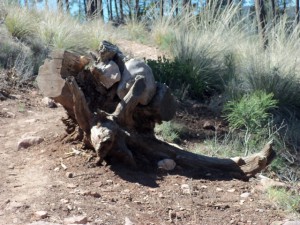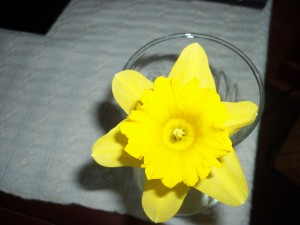Last week I enjoyed a different perspective on the Arizona Pine Trailhead trail.
Although a kazillion views of trees surrounded me, this one warranted a picture, an uprooted specimen with large rocks imbedded in its roots.
Wow, the parallels we could draw! But one simple fact intrigues us–the roots still cling to these rocks. Even though the tree’s been pulled from its moorings, its moorings stuck to it.
Ain’t that the truth about us? We may try to outrun our history, but no matter what, there it is. For example, we’ve known a man for over thirty years, and his choices have baffled, disappointed, and sometimes infuriated us. But just today, I heard about his mistreatment at the hands of a severe father. Life-threatening abuse.
This doesn’t excuse our friend’s decisions, of course, but realizing the rocks imbedded in his roots reminds us there are reasons for his behavior. Those physical, emotional, and verbal beatings he suffered as a kid still resonate in his inner being, though his father died long ago and he’s now a grandfather himself.
Later on the day of my hike, I was wandering in our yard and came upon this sprightly bit of cheer. Nothing as yellow and encouraging as a daffodil.
There it was, blooming its little heart out, right in the treacherous path of elk and deer and javelina.
But somehow, it survived and testifies to the other side of things–one can grow up in nasty danger and yet thrive.
Patricia Evans, a pioneer in the field of verbal abuse, has something to say about this.
“Although people subjected to verbal abuse can recover, the confusion, pain and loss are beyond counting. Childhood anguish can, however, count for something: It can be transformed into the passion and determination needed to take a stand against verbal abuse and for awareness and life. This stance can be put to good use, to bring awareness, to save countless others from the relentless erosion of their self-perception, their personal reality, their minds.” —
Patricia says, “This is an excerpt from my next book, readers will discover how to protect their children from verbal abuse. It will be announced this year, on www.verbalabuse.com.”
Our characters may have a backstory of abuse that figures into their present behavior. A couple of my women’s fiction novels feature heroines facing such after-effects. Whether it’s in 1870 Arizona Territory or at the eve of World War II, healing takes time–sometimes a great deal of time. But these women conquer and I can’t wait until you all can meet them.
And if you have questions for Patricia, please feel free to ask and/or visit her site, which has many helpful resources. Thanks for stopping by.



Gail, I love how you interweave the good and the bad, the mundane and the unusual, the past and the present into a new perspective. I especially appreciate how your story lessons are optional, but always interesting!
Oh Janey, you made my day. I think reading your writing has probably increased my skills. Thanks for taking the time to comment here – is it white there yet?
Gail
Gail, this is such an important post. I think we all have our own “rocks,” but we get to choose what we do about them. Thank you for sharing Patricia’s excerpt. While verbal abuse isn’t one of my rocks, her encouragement to transform “bad” for “good” is a positive message for each of us.
On a lighter note, I also love the daffodil photo. We have them popping up all over the place here. So lovely!
Aren’t they the most encouraging, cheerful little touches to our world? Thanks so much for your “rocks” comments, Johnnie. Seems like the playing field’s even when it comes to rocks (not to mix metaphors!!)
This post hits too close to home. But if we bathe ourselves daily in the lovely Words of God, there is great healing there. I’m grateful that I can replace those tapes in my head by what my Heavenly Father says I am!
Amen to that, Ane. Thanks for visiting.
Oh good grief – you remind me of Ane Mulligan, Karla, and I looked only at the words, not your picture! My bad – sorry!
Great post, Gail and an important topic!
Such an important topic, and as a writer, it’s crucial to portray the effect of harshness and/or verbal abuse on the characters depending on their inherent personality.
And eager-to-please person might handle the harshness differently than a passive/aggressive loner. So once you have your character’s personality nailed, then you can develop their reaction (or over-reaction or emotional “buttons”) based on the personality quirks you gave them. This is a great way to differentiate your characters and make a difference in people’s lives!
Love your take on this, Ruth. It usually takes me a while to coordinate the quirks with the emotional buttons, but even the effort is healing for me. Does that make sense? I think I get stronger right along w/my heroines.
Thanks for stopping.
I love this: “I get stronger right along w/my heroines.” Maybe we should offer a “Writing as Therapy” session sometime at the Cedar Falls writers workshop! My understanding deepens with my writing also and comes along with diagrams. I call it “drawing my own confusions.” 🙂 I love the way you intertwine life and nature, Gail.
Great idea, Jean, about the workshop. Sounds like you could facilitate it, or we could co-lead. That would be fun. Glad you mentioned the Cedar Falls writers’ conference, for anyone who might be looking for an affordable midwestern one.
God protects the daffodils. Why not the tulips. The daffodils have a bitter taste that doesn’t appeal to rabbits and deer. Maybe that’s why they leave me alone too.
Years ago it was: sticks and stones can break my bones but words will never hurt me. We know this isn’t true as it is now labeled verbal abuse. Some don’t even know they do it. Others are learning through twitter and tweet, with comments they made without thinking, that the wrong words can have devastating results-maybe not abuse but these quickly pecked words cause harm to many.
Roots are interesting. We have much in common with them. Roots aren’t always under the plant but they manage to adapt and find another way just as we do. Much nurishment is needed for both. We can learn much from plant roots and family roots.
I enjoy your blog but the computer is a long way from where I usually am-so not much time is spent there. Welcome back Gail.
Boy, Mary, there’s a lot to glean from what you wrote.
And you’re so right about the tweeting, yet another manifestation of names HURTING. That’s something I hadn’t thought of in light of this particular post.
I’m glad to be back, looking forward to seeing you. Thanks for taking the time to get to your computer!
This was a wonderful post, Gail. So glad I ran across it. Love your impacting insights, and I too love that daffodil photo. We should be seeing them in our neck of the woods in the next few weeks. Blessings on you…
Thanks, Sharlene. One year my daffodils bloomed here in Iowa, then froze one night b/c I failed to watch the weather. Our little grandson saw my angst over them the next morning and said, “Don’t feel bad, Grandma…I can fix them.” Smile…hadn’t thought of that story for a while.
I appreciate you stopping by tonight.
Thanks, Gail, for this insightful simile and the wisdom it carries. I agree with Karla about the healing words God uses to help us find peace in the chaotic world of abusive words in which we live.
Carol, thanks for your insight – chaotic world, that’s for sure!
Great post, Gail! Anyone who writes (or valiantly attempts to) knows the power of words. That power can wound, but it also can heal. Our stories, fictional or not, are important. To tell them requires courage often and determination certainly. The subjects are not always popular but that is even greater reason to speak of them.
On a less melodramatic note, it was great sharing with you these past few months. Here’s to all the daffodils! Many thanks.
And here’s to you, Marianne, b/c your plunging into your writing with courage! So good to meet you and work with you this winter.
And I’m toasting the daffodils down in AZ this a.m. as I look out on a totally white world here in Iowa. SMILE
What a striking photo, and a powerful reminder that we’re all clinging to stones and are often too quick to judge others. Thank you!
Sara, you always thing of some new aspect – yes, the stones do remind me not to judge…who knows what someone might be lugging around in their roots!
Thanks for taking the time to stop by,
Excellent post, Gail. That tree looks, at first glance, like a cave man sitting on the ground. Yes, it’s early and I haven’t had more than 1 sip of coffee yet. lol I had to enlarge it to realize it was a tree!
I thought it was a little dark, too. But it was about a mile in on the trail and I left AZ a couple days later. Will have to revisit/rephotograph next winter when we return. Thanks for your visit, with or without your coffee, Ane!
Seeing your daffodil made me smile. How dazzling it is – almost defiant in its barren, cold and inhospital surroundings. For you it became a metaphor. For the oppressed it represents hope and victory. Wow.
And seeing your comment makes ME smile, Adriane. Thanks for coming by, and thanks for your help!! See you next week, I hope, and maybe more daffodils will be peeking through by then, eh? Hope so.
I am blessed to “meet” you lovely women thru Gail. Now I must say I have fallen in love with Gail’s writing. I think it is because it seems to almost show life itself to be a metaphor for the blossoming of consciousness on this ‘chaotic’ planet.
I have always wondered why many people consistently define the inner reality of a spouse or child, yet don’t feel ‘crazy’ doing so. My wondering has led me to write the five books I currently have in print and to be working on another one.
No person, but you, knows what you are, think, feel, want, are trying to do, know, need, etc., unless you tell them.
I hope to stop by again.
Patricia, it’s great to have you here. Thanks again for allowing me to quote you, and I wish you all the best with your upcoming book. It’s wonderful that you use your gifts to unveil the truth for others, and thanks so much for the encouragement you always give me.
Gail